Rattlesnake Bite
The patient is a 40 year old Trauma-Surgical Intensive Care nurse who got bitten by a 14 inch rattlesnake in his back yard. He was bitten while trying to remove it, since this is where his 4 year old plays. He tried to manipulate the snake with a very short stick and was bitten in the left index finger. He presented to the MGH ER and I was consulted.
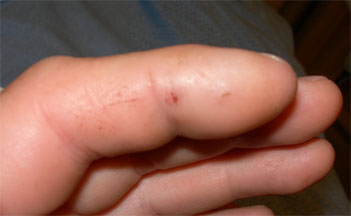 |
| The reddish puncture wound just distal to the DIP finger crease is one fang mark; the faint scratch proximal to the crease was made by the second fang. |
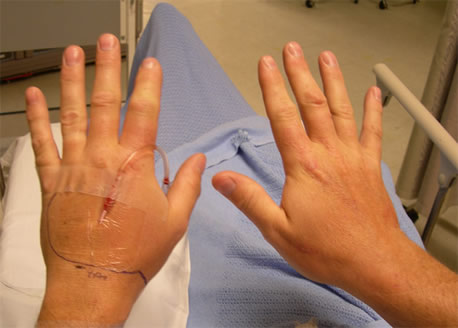 |
| The bite is to the left index finger. This picture was taken about 3 1/2 hours after the bite. The swelling is going down with treatment, and there is no tissue destruction. He was lucky, it was a small snake, and he probably had only a small envenomation. |
 |
| Luckily, the patient has little pain. These injuries can be very painful, if the envenomation is larger. (The patient, a nurse, gave his permission for this photograph and for me to post it here for patient education.) |
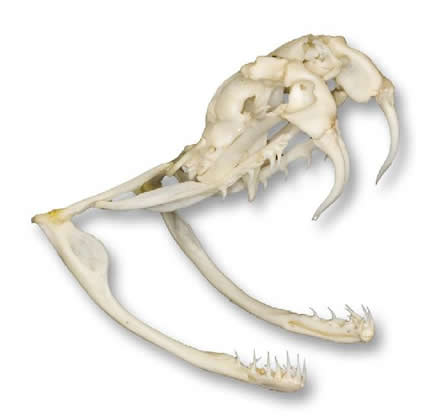 |
| The rattlesnake has two active hollow fangs and several extra, non-active fangs that are growing in (not shown). They are hollow, and the hole is several millimeters from the tip. In this patient's case, I think only one fang penetrated deep enough to inject venom. (This image is from Skulls Unlimited; used with permission.) |
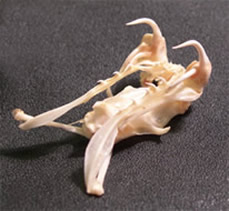 |
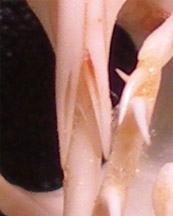 |
|
| This is a photograph of a rattlesnake skull in my personal collection (purchased from Skulls Unlimited, the source of the photo, above). Note the two prominent fangs; also not that there are multiple other fangs folded up at the base of the main fangs, ready to move into position if the snake loses a main fang. Note also the smaller teeth in the mandible, which help the snake to hold onto and swallow their prey. | This is a close-up of the skull on the left showing the elongated hole that the venom comes out of. The fang needs to penetrate beyond the end of the hole in order to properly envenomate the victim. In the above clinical case, it would appear that only one fang penetrated deep enough to envonomate him. |
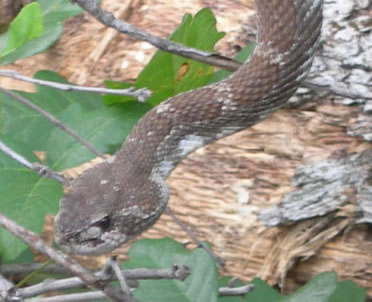 |
This is a four foot Crotalus atrox (Western Diamondback rattlesnake) seen in Yosemite, above Hetch Hetchy, in 2008. We stayed well beyond 5 feet from the snake (they cannot strike more than about 2/3 of their length, so staying at least a full bodylength away is a good idea). The pits that chararcterize this snake as a pit viper (rattlesnakes, copperheads, and cottonmouths) can easily be seen between the eye and the nostril. |
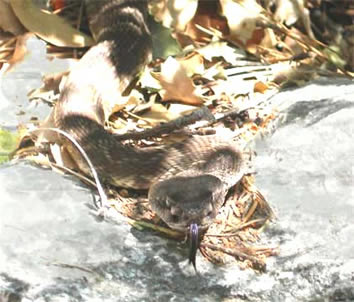 |
| This is a Western Diamondback rattlesnake we found in Yosemite Valley in 2006 and were able to observe hunting for about 30 minutes. It completely ignored the people around watching it. The pits can easily be seen in this photograph. Again, we stayed well away from the snake (the photo was taken about 6 feet away from this 3 foot long reptile). |
Current treatment is based on administration of a sheep-serum based antivenom medication, CroFab. The previous treatment, Antivenin Crotalidae Polyvalent, or ACP, was a horse-serum based medication released in 1954 by Wyeth Laboratories. It had both a therapeutic component, whole immunoglobulin G, and another component, Fc, which was immunogenic and caused an acute anaphylactic reaction in 23% to 56% of patients as well as a delayed serum sickness in 10% to 100% of patients. It is no longer used because of its toxicity and because it did not cover a very broad spectrum of species of Crotalus. Some rattlesnakes (eg, the Mojave rattlesnake) have a neurotoxic component, but not all, and ACP did not cover them.
"In 2001, Crotalidae Polyvalent Immune Fab (CroFab; BTG International, West Conshohocken, PA) was introduced as a promising alternative to ACP. Sheep are immunized with the venom of eastern and western diamondback rattlesnakes, Mojave rattlesnakes, and cottonmouths. The serum obtained from the sheep is then digested with papain, a protease that isolates the Fab and Fc fragments of the immunoglobulin, which are then isolated and removed. Four specific Fab preparations are combined to form the final product. The end result is a highly purified antivenin that lacks the immunogenic Fc fragments and proteins. In clinical trials, the overall rate of serum sickness following administration of CroFab was 16%, and the rate of acute reaction was 14.3%. These rates are substantially lower than those reported with ACP. Anaphylaxis has not been reported with CroFab." (Journal of the AAOS, see References)
The largest problem with treatment of snakebite is that everyone has been taught how to treat it, but the treatments that most people have learned (often by Hollywood movies or popular outdoors magazines) are wrong. The very old "cut-and-suck" method (think how many Cutter snakebite kits have seen sold) has been abandoned because it did not help and often made things worse. Almost everyone knows you need a tourniquet to treat snakebite. However, tourniquets have caused significant injuries if very tight (arterial pressure levels) by causing ischemia (no arterial blood flow), if fairly tight (venous pressure levels) or even if fairly loose (lymphatic pressure levels) by concentrating the venom in a small area and exacerbating tissue necrosis, coagulation abnormalities, bleeding, etc. Formal studies of tourniquets with models of venom have shown that there are many disadvantages and no clear advantages. Tourniquets are now only advised when the patient is developing life-threatening symptoms and only for short-term use, recognizing that the injury to the extremity may be worsened.
Patients need to be transported as quickly as possible to the nearest emergency room, where the antivenom medication can be administered. Avoid moving the extremity or increasing heartrate, as this will tend to mobilize the venom into the rest of the body.
For Medical Professionals
It is advisable to contact your local Poison Control Center (1-800-222-1222) for the most current recommendations and the precise method by which to administer the antivenom. Some of the information on this page was obtained from my local Poison Control Center on July 2, 2008, and the sources listed at the end of the page. This information was used successfully to treat the above patient, and is considered reliable at this date; again, contact your local Poison Control Center for the most current recommendations. Additional information concerning the use of CroFab can be obtained at the CroFab Hotline at 1-877-377-3784.
The antivenom is called CroFab (brand of Crotalidae Polyvalent Immune Fab [Ovine], developed and manufactured by Protherics PLC, Nashville, TN, and distributed by Fougera [800-231-0206], a division of Altana Inc. and has been available since December, 2000). As the name indicates, it is a sheep-based immunoglobulin (unlike Antivenin [Antivenin Crotalidae Polyvalent], the horse-serum based product by Wyeth Laboratories, which used to be used; there is less of a chance of allergic reaction to the sheep-based product). It is polyvalent in that it is a combination of four monovalent antivenins against four venomous snakes in the US (Crotalus atrox (Western Diamondback rattlesnake), Crotalus adamanteus (Eastern Diamondback rattlesnake), Crotalus scutulatus (Mojave rattlesnake), and Agkistrodon pis-civorus (Cottonmouth or Water Moccasin). Note: this is not effective against the coral snake, which has quite a different venom; it is neurotoxic, while the others above are hemotoxic. These characterizations are a bit simplistic, but serve a first-order characterization for non-specialists. For coral snake bites, see eMedicine.
All patients with suspected venomous snakebite should be admitted for 24 hours, because of the late development of life-threatening symptoms and because of the unreliability of most histories. Recommendations include documenting, if possible, the species of snake (to many people, all snakes are "rattlesnakes"), the site of envenomation, the precise area of redness and swelling (mark in ink, date and time, and chart including person perforing the exam; often, later care providers have no other access to this initial data), and measure circumference of extremity and chart. Support BP with fluids. Administer CroFab as soon as reasonably possible, with 4 to 6 vials. CroFab can limit additional cellular injury; it does not reverse necrosis already present. In general, it needs to be given within 6 hours of envenomation for best results. (See page 2 of the first reference, below, for specific reconstitution and administration guidelines).
A grading system of envenomations has been developed and is presented in the AAOS article (see Refences). Authors have emphasized that grading envenomations is a dynamic process and additional antivenom should be given as indicated by a worsening clinical course. Continue to measure the extremity swelling (by documenting the circumference) and mark the leading edge of the swelling every 30 minutes until it has been stable for 4 hours. If the swelling is noted to be increased at the end of the first hour of observation, then 4 to 6 more vials of Crofab should be given IV over 2 hours with continued frequent checking of the measurement of the affected part. If it is stable or decreased, then the Crofab is given two vials every 6 hours for 3 more doses. It should then subsequently be checked every 2 hours up until 24 hours after the initial bite.
There is a report of a delayed reaction for reasons that are not entirely understood. If there is any hint that the swelling is not completely stable, the patient should be observed for a longer time than the first 24 hours. Up to 18 vials have been administered; there is no clincal data for more than 18 vials.
The indication for labs studies and their frequency are controversial. The AAOS article suggests baseline labs, including coagulation profiles (PT, PTT, IRN), CBC (including platelets), fibrinogen. They should be repeated in 2 or 3 hours if clinically indicated (many patients will not actually have a snakebite, many others will have been bitten by a nonpoisonous snake, and still others may have been bitten by a venomous snake but not have any envenomation). Alternatively, the poison control center suggested that labs (CBC, PT/INR, CPK, BUN and creatinine, although this is only expected to be affected if there is rhabdomyolysis) do not need to be checked upon arrival and can be checked the following morning, and base initial treatment on clinical signs of swelling, etc.m as noted above. In any case, the patient should be placed in a monitored unit in part because of the frequency of the checks as well as to follow cardiovascular status.
If your institution does not stock more than 6 vials, request the pharmacy to initiate inquiries right away for the location and availability of additional supplies. Usually, most hospitals use CroFab so infrequently that they cannot afford to stock very much. The minimum recommended treatment requires 10 vials, larger envenomations will require more, up to 18 vials. It is preferable for the pharmacy to know which other hospital pharmacies stock CroFab in advance of actually needing it. As soon as the patient presents, contact the pharmacy and ask them to locate further CroFab.
Patients who are believed to have a "dry bite" (no venom was injected, incidence is from 10% to 50% of bites) should be observed for at least 8 hours, but 24 hours is preferable. A close follow-up and/or recheck examination is recommended. Patients have been reported who initially did not exhibit signs of envenomation returned in several hours with significant injury and required admission for treatment with IV CroFab.
Complications
The venom's mode of action is complex, but inhibition of coagulation is one of the key methods of killing the snake's prey. Therefore, the patient needs to be monitored for coagulapathy ( CBC, PT/INR). A second mode of action is muscle destruction, so the patient needs to be monitored by checking the CPK, BUN and creatinine. These are late effects, and labs can be drawn the following morning.
Compartment syndrome can develop in more severe cases of envenomation. The patient's level of pain and compartment enduration should be observed. Pulselessness distal to the compartment is a classic sign of compartment syndrome BUT IS INCORRECT. Compartment syndrome occurs when capillary perfusion pressure is less than compartment pressure. The arterial pressure will always be higher than capillary perfusion pressure, and therefore distal pulses are very misleading in the diagnosis of compartment syndrome. Pain, pain on passive stretch (ischemia renders muscles painful to stretch), and pain more than anticipated are much more important clinical signs. The adage that "if you are thinking that compartment pressures need to be measured, you need to measure them" is still correct.
Reactions
The most common reactions to sheep serum are urticaria and rash.
Prognosis
According to eMedicine, "Since the development of antivenom, rapid EMS transport, and emergency/intensive care, mortality rates have improved to less than 0.28% when antivenom is administered and to 2.6% when antivenom is not administered." The age, size, and health of the patient, plus the amount of venom injected, are primary determinants of the degree of injury and the chance of mortality.
References
http://en.wikipedia.org/wiki/CroFab (excellent article for medical professional faced with treating a snakebite; note the utility at the bottom of the first page for moving to the next page; the reference is 7 webpages long)
https://www.uptodate.com/home/index.html (unfortunately, this reference requires a substantial fee for access)
Managment of Venomous Snakebite Injury to the Extremities, Journal of the AAOS, December 2010.
